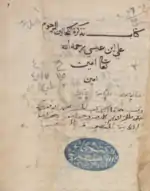Ali ibn Isa al-Kahhal
ʿAlī ibn ʿĪsā al-Kahhal (Arabic: علي بن عيسى الكحال) (fl. 1010 AD), surnamed "the oculist" (al-kahhal) was the best known and most celebrated Arab ophthalmologist of medieval Islam.[1][2] He was known in medieval Europe as Jesu Occulist.

He was the author of the influential Memorandum of the Oculists, where for the first time in the literature a surgical anaesthetic is prescribed.[3]
He wrote the landmark textbook on ophthalmology in medieval Islam, Notebook of the Oculists, for which he was known in medieval Europe as Jesu Occulist, with "Jesu" being a Latin translation of "Isa", the Arabic name for Jesus.
Ibn 'Isa is considered one of the most famous physicians of the tenth century. His famous Notebook of the Oculists combined information obtained from both Greco-Roman and Arab sources. The book encompassed information on treatment and classification of over one hundred different eye diseases. In the book, eye diseases were sorted by their anatomical location. The Notebook of the Oculists was widely used by European physicians for hundreds of years. Ibn Isa's book was one of the first, along with Hunayn ibn Ishaq's Ten Treatises on the Eye, to illustrate anatomy of the eye. Specifically, Ibn Isa illustrated the optic chiasm and brain.[4] Ibn Isa was the first to describe and suggest treatment for an array of diseases. For example, he was the first to discover the symptoms of Vogt–Koyanagi–Harada syndrome (VKH) - ocular inflammation associated with a distinct whitening of the hair, eyebrows, and eyelashes.[5] Ibn Isa was also the first to classify epiphora as being a result of overzealous cautery of pterygium. In addition to this pioneering description, Ibn Isa also suggested treatments for epiphora based on the stage of the disease – namely treatment in the early stages with astringent materials, for example ammonia salt, burned copper, or lid past and a hook dissection with a feathered quill for chronic stages of epiphora.[6] Ibn Isa is also thought to be the first to describe temporal arteritis, although Sir Jonathan Hutchinson (1828–1913) is erroneously credited with this.[7]
References
- E., Mittwoch. "ʿAlī b. ʿĪsā".
- Griffin, Rosarii (2006). Education in the Muslim World: different perspectives. Symposium Books Ltd. ISBN 9781873927557.
- Peters, F. (1973). Allah's Commonwealth: a history of Islam in the Near East, 600-1100 A.D. Simon and Schuster. p. 391.
- Lin, Daren (2008). "A Foundation of Western Ophthalmology in Medieval Islamic Medicine" (PDF). UWOMJ. 78 (1): 41–45. Archived from the original (PDF) on 2011-07-17. Retrieved 2011-06-14.
- Paredes, I; Ahmed, M; Foster, C S (2006). "Immunomodulatory therapy for Vogt-Koyanagi-Harada patients as first line therapy". Ocul Immunol Inflamm. 2006 (14): 87–90. doi:10.1080/09273940500536766. PMID 16597537.
- Hirst Lawrence, W (2003). "The treatment of pterygium". Surv Ophthalmol. 48 (2): 145–80. doi:10.1016/S0039-6257(02)00463-0. PMID 12686302.
- Baum, E; Sams, WM; Payne, R (1982). "Giant cell arteritis: a systemic disease with rare cutaneous manifestations". J Am Acad Dermatol. 6 (6): 1081–1088. doi:10.1016/s0190-9622(82)70094-5. PMID 7096671.